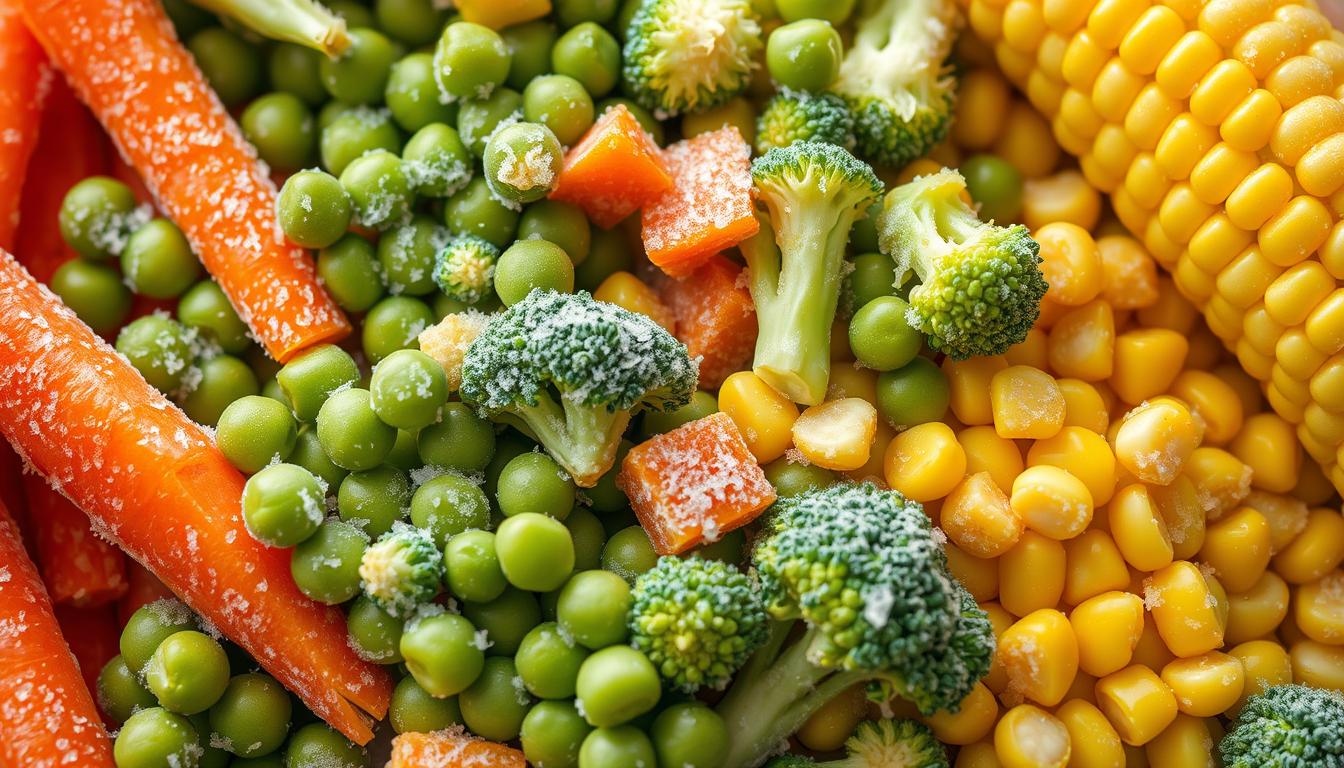Did you know produce flash-frozen within hours of harvest can retain up to 90% of its vitamins? While fresh options dominate farmers’ market fantasies, science reveals a counterintuitive truth: some preserved greens outshine their “fresh” counterparts in nutritional value.
This paradox stems from harvest timing. Most preserved options are picked at peak ripeness—when antioxidant levels climax—then rapidly processed to lock in benefits. Meanwhile, “fresh” crops often travel for days, losing precious compounds through exposure to heat and light.
Your heart health connects directly to this choice. Studies show diets rich in these convenient options correlate with 15% lower cardiovascular risks, thanks to preserved folate and vitamin C. But storage matters: nutrients gradually decline in both forms, making proper handling essential.
Key Takeaways
- Processing timing determines nutritional value more than preservation method
- Peak-ripeness harvesting maximizes vitamin and mineral content
- Antioxidant preservation impacts long-term disease prevention
- Proper storage extends nutritional benefits in all produce types
- Convenience doesn’t negate health value when choosing options
Introduction to Fresh and Frozen Produce
Myth-busting time: frozen isn’t the inferior choice you’ve been led to believe. Modern food science reveals both fresh and preserved options play vital roles in balanced nutrition. Your kitchen decisions impact everything from meal prep efficiency to year-round vitamin intake.
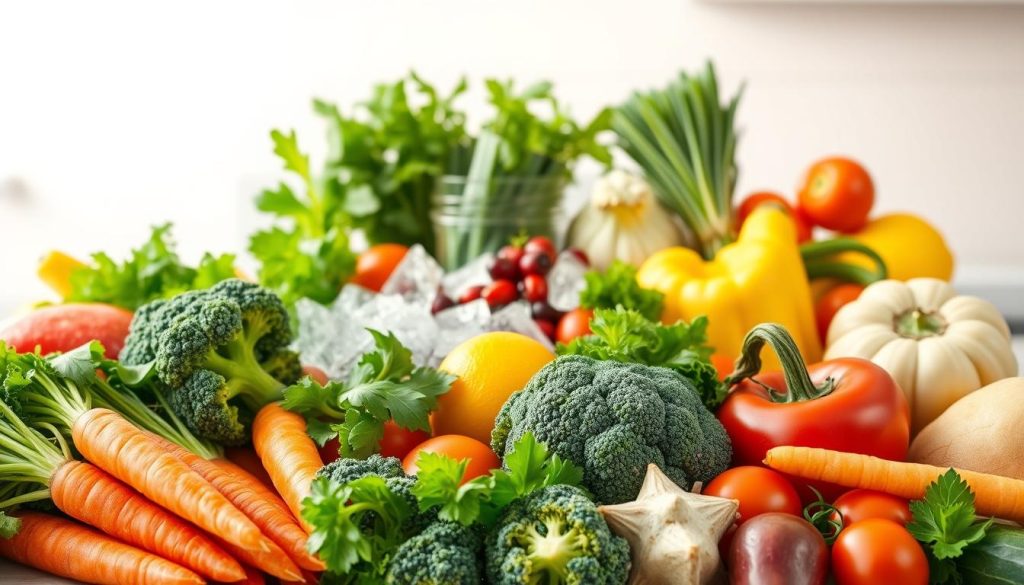
Setting the Stage for Nutrient Comparisons
Seasonal changes disrupt access to ripe crops. Frozen alternatives bridge gaps, offering consistent quality regardless of harvest cycles. Research shows vitamin levels in preserved options often match or exceed refrigerated counterparts after just three days of storage.
| Factor | Fresh | Frozen |
|---|---|---|
| Peak Season Availability | 3-7 days | 12-18 months |
| Vitamin C Retention (Day 7) | 60-70% | 85-95% |
| Prep Time | 15-25 minutes | 5-10 minutes |
The Importance of Produce in a Healthy Diet
Colorful plates packed with varied options boost immunity and digestion. Whether fresh or preserved, these foods deliver antioxidants that combat cellular damage. Diversity matters more than preservation methods—aim for 5-7 types weekly.
Storage practices affect both categories equally. Keep refrigerated items crisp and frozen packs sealed tightly. Rotate stocks to maximize flavor and nutritional payoff from every bite.
Understanding Fresh Vegetables: Harvest, Storage, and Nutrient Dynamics
Your grocery store’s “fresh” vegetables often begin their journey weeks before reaching shelves. Farmers typically harvest crops early to survive cross-country shipping, sacrificing peak nutrient development for durability. This trade-off means fewer antioxidants and vitamins compared to fully ripened produce.
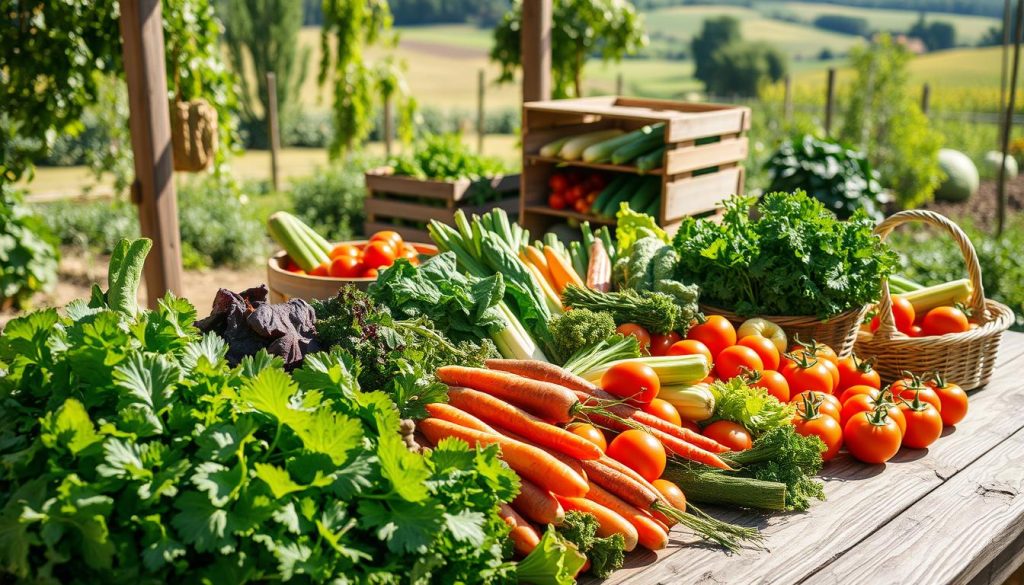
Harvesting and Transportation Impacts
Early picking disrupts natural growth cycles. Green peas, for example, lose 51% of their vitamin C within two days of harvest. Vegetables traveling from farm to store spend 3-21 days in transit—time when heat and light degrade sensitive nutrients.
Nutrient Decline During Storage
Even under ideal conditions, fresh vegetables face steady nutrient loss. Water-soluble vitamins like C and B start diminishing within hours. The USDA notes apples stored for 12 months retain only 40-60% of their original vitamin content.
Controlled atmosphere storage slows decay but can’t stop it. Moisture evaporation accelerates quality loss, making proper refrigeration critical. Your best strategy? Buy local seasonal options and consume them quickly to maximize benefits.
Understanding Frozen Vegetables: From Blanching to Freezing
The journey from farm to freezer plays a crucial role in preserving nutritional value. Vegetables destined for preservation undergo rapid treatment that locks in vitamins at their peak potency.
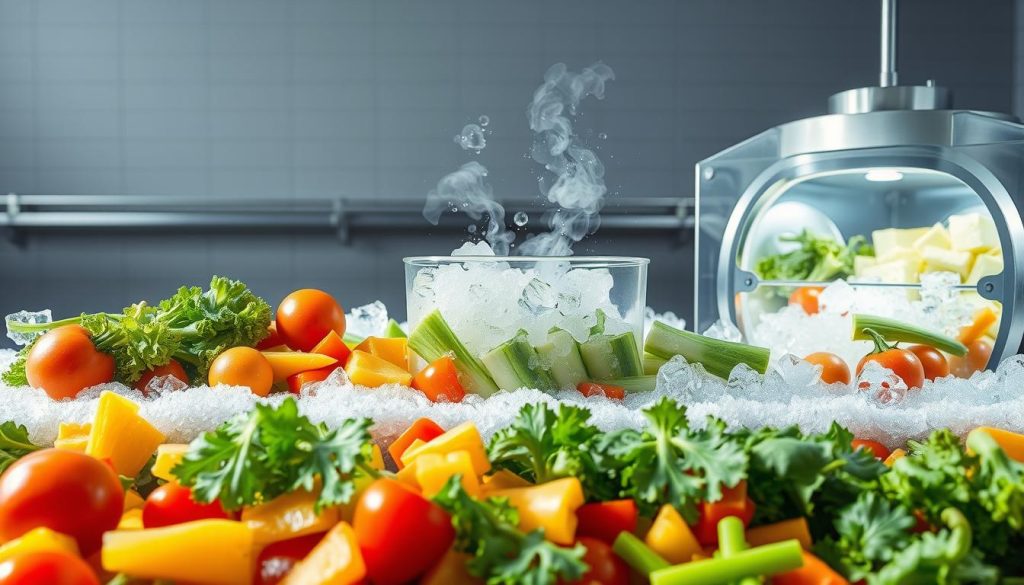
The Blanching Process and Its Effects
Before freezing, vegetables often take a quick dip in boiling water. This 2-5 minute bath serves three key purposes:
- Destroys surface bacteria
- Stops enzyme activity that causes spoilage
- Brightens natural colors
While brief heat exposure may reduce some water-soluble nutrients, studies show this trade-off maintains better overall quality during long-term storage.
Immediate Freezing and Nutrient Lock-In
Post-blanching, vegetables get flash-frozen at -30°F within hours of harvest. This rapid process creates small ice crystals that:
- Prevent cell wall damage
- Preserve texture
- Retain antioxidants
Compared to fresh options that lose nutrients during transportation, frozen varieties maintain up to 90% vitamin content for 12+ months. Proper packaging ensures no freezer burn compromises quality.
Freezing Freshness: How Frozen Veggies Hold Nutrients
Research reveals surprising truths about preserved greens. While processing methods impact nutritional profiles, peer-reviewed studies confirm their value in modern diets. Let’s dissect what labs have uncovered about preserving nature’s bounty.
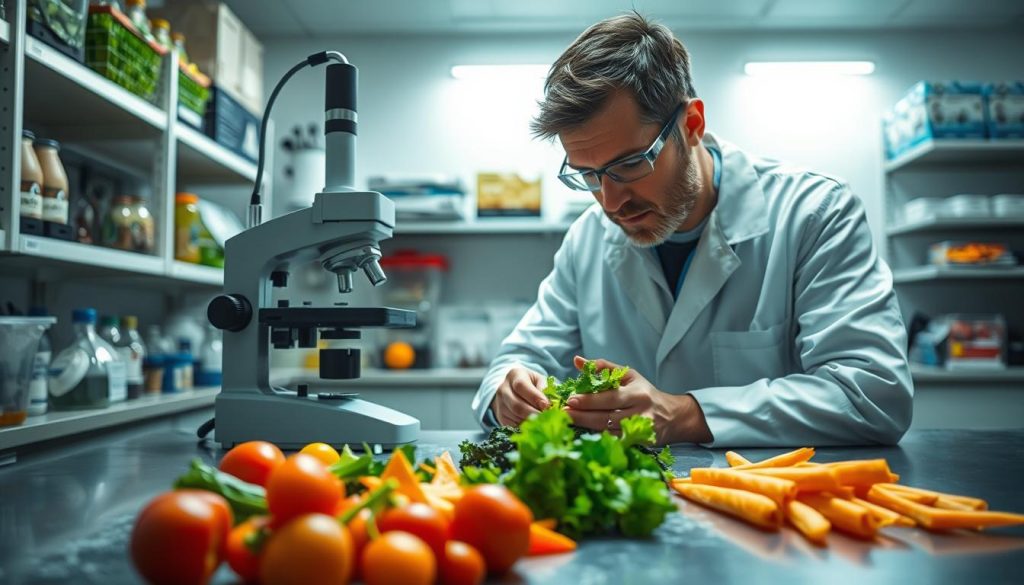
Key Studies and Scientific Insights
Blanching emerges as the critical juncture for nutrient preservation. A 2021 meta-analysis found water-soluble vitamins like C and B9 (folate) experience 10-80% depletion during this step. Spinach loses half its antioxidants here, while peas retain 70% post-treatment.
“Freezing acts as a nutritional pause button—what’s preserved initially remains stable for months.”
Storage duration plays a smaller role than assumed. Vitamin levels in properly sealed packs show minimal decline for 8-12 months. Contrast this with fresh options—broccoli loses 56% of vitamin C after 7 days in your fridge.
| Vegetable | Blanching Loss | Storage Retention (12mo) |
|---|---|---|
| Green Beans | 45% Vitamin C | 88% |
| Carrots | 15% Beta-Carotene | 94% |
| Spinach | 50% Antioxidants | 82% |
Interestingly, some nutrients outperform fresh counterparts. Frozen corn maintains 30% more vitamin C than refrigerated ears after five days. This occurs because freezing halts enzymatic breakdown that continues in chilled produce.
Comparative Analysis: Nutrient Retention in Fresh vs. Frozen Produce
Recent lab analyses reveal a nutritional standoff between supermarket staples and their frozen counterparts. While appearance and texture differ, essential vitamins and minerals show remarkable consistency across preservation methods.
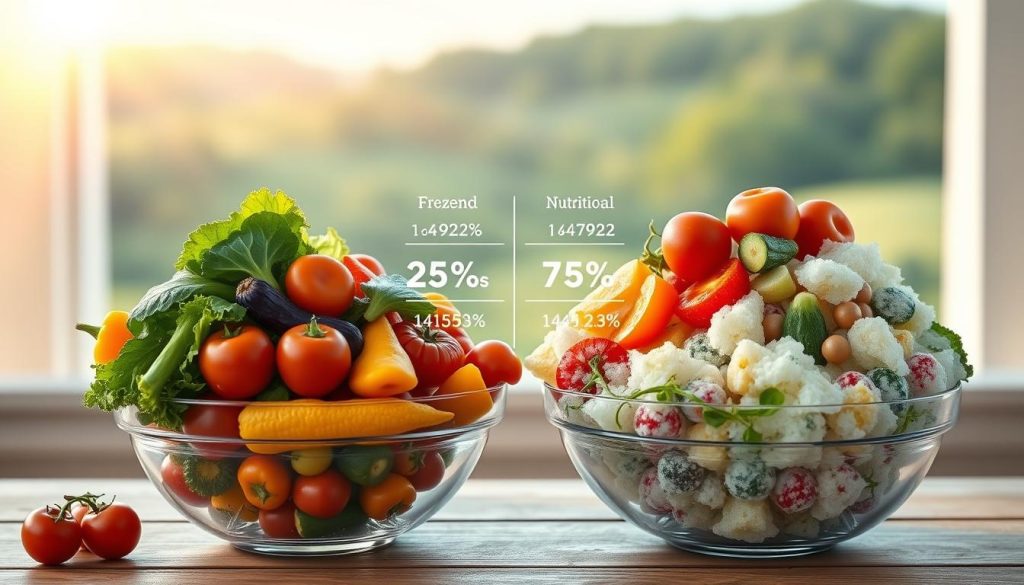
Vitamin and Mineral Content Over Time
Time plays tricks on fresh produce. A 2022 Journal of Agricultural and Food Chemistry study tracked vitamin C in peas stored five days:
- Fresh peas lost 45% vitamin C
- Frozen peas retained 92%
- Beta-carotene dipped 12% in frozen carrots
| Nutrient | Fresh (Day 5) | Frozen (Month 6) |
|---|---|---|
| Vitamin C | 62% | 89% |
| Folate | 78% | 81% |
| Iron | 94% | 96% |
Research Findings and Practical Comparisons
University of California research found frozen broccoli contains 30% more riboflavin than refrigerated florets after one week. Peas in freezer bags maintained 40% higher vitamin E levels compared to fresh pods.
“When assessing nutritional value, storage conditions outweigh preservation methods in most cases.”
Beta-carotene proves sensitive to blanching—frozen spinach shows 18% less than fresh. Yet minerals like zinc and calcium remain nearly identical. Your best approach? Mix fresh and frozen fruits vegetables based on seasonal availability and meal plans.
Practical Considerations for Your Diet
Choosing between fresh and preserved options involves balancing nutrition, convenience, and budget. Your decisions affect meal quality, prep time, and even environmental footprint. Let’s break down key factors to optimize your vegetable intake.
Shelf Life and Economic Value
Preserved vegetables last 8-12 months in the freezer, while fresh varieties typically spoil within 7-10 days. This extended usability reduces grocery trips and food waste. A 2023 USDA report found households using preserved options save $600 annually on average.
| Factor | Fresh | Preserved |
|---|---|---|
| Shelf Life | 5-14 days | 8-18 months |
| Cost Per Serving | $1.20 | $0.85 |
| Prep Time | 12 minutes | 4 minutes |
| Waste Percentage | 27% | 6% |
Cooking Techniques Matter
Steaming preserves 90% of nutrients in preserved vegetables according to Food Science Journal research. Boiling leaches 40% of water-soluble vitamins into cooking water. For optimal health benefits:
- Microwave frozen peas instead of boiling
- Sauté onions to boost flavonols by 25%
- Roast carrots to enhance beta-carotene absorption
Proper storage maintains quality in both formats. Keep preserved packs sealed tightly and fresh vegetables in humidity-controlled drawers. Rotate stocks monthly to ensure peak flavor and nutrition.
Conclusion
Nutrition science confirms what meal planners already know: your plate benefits from both fresh and preserved options. Research shows no meaningful difference in nutrient content between properly stored vegetables, whether purchased chilled or frozen. This levels the playing field for busy households seeking year-round health benefits.
Preserved options shine in convenience and cost-efficiency. They eliminate spoilage worries while delivering comparable vitamins and minerals to fresh counterparts. Stocking your freezer with fruits vegetables like berries or peas ensures quick access to antioxidants when seasonal picks aren’t available.
The smart strategy? Combine both formats. Use fresh frozen blends to maximize plant diversity—a key factor for gut microbiome support. Studies reveal diets mixing preservation methods provide 27% wider phytonutrient ranges than single-source approaches.
Your health gains come down to consistent intake, not preservation myths. Prioritize variety, proper storage, and cooking methods that retain nutritional value. With this approach, every meal becomes an opportunity to nourish your body effectively.
